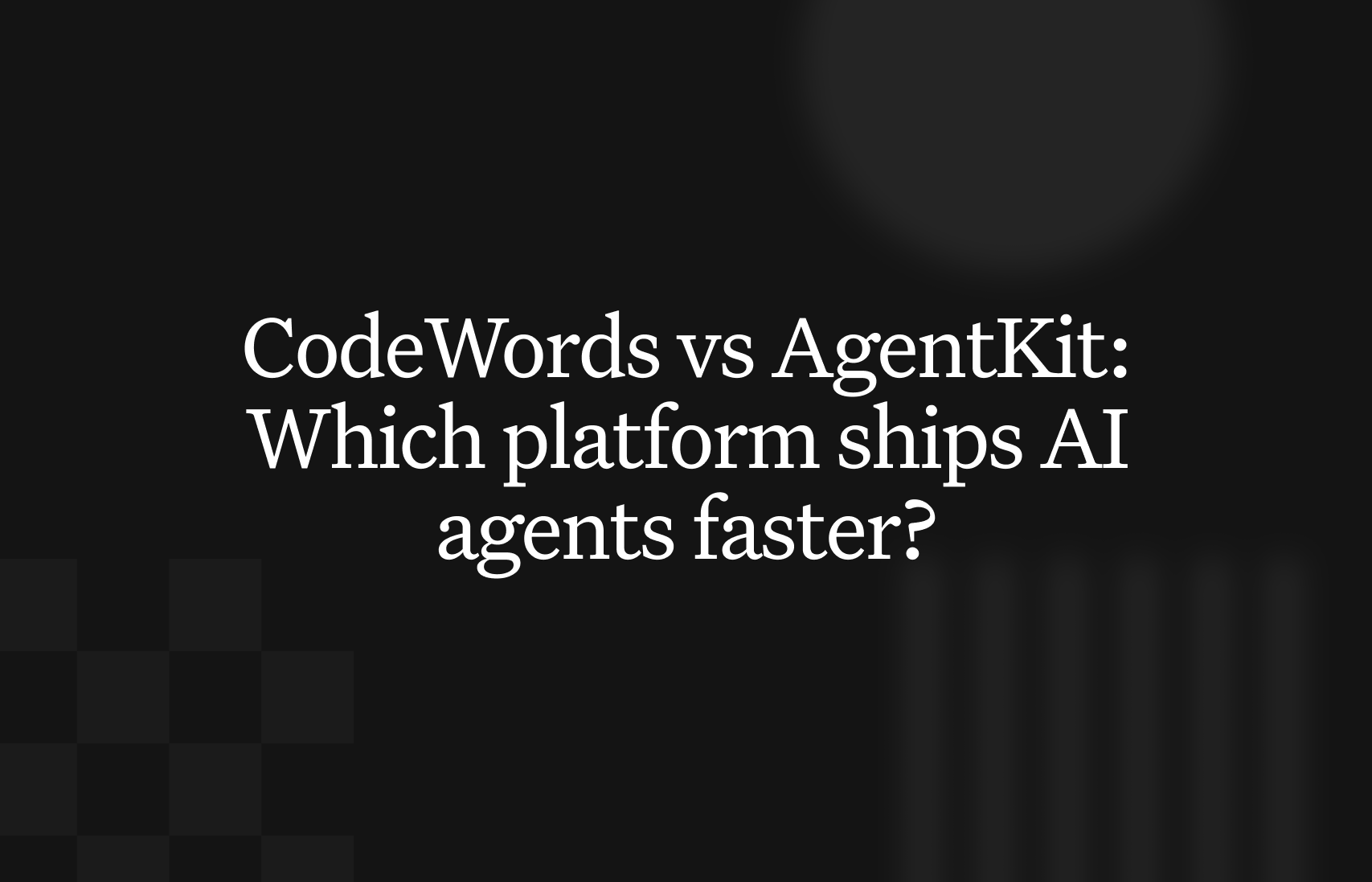Most AI agent platforms promise speed but deliver complexity. You're choosing between OpenAI's AgentKit — a visual builder with enterprise connectors — and CodeWords, a serverless automation platform that executes workflows in natural language. Both claim to accelerate deployment, but they solve fundamentally different problems.
OpenAI AgentKit excels at orchestrating complex multi-agent systems with custom guardrails, while CodeWords eliminates coding entirely through natural language prompts that trigger 2000+ pre-built service integrations.
In Q3 2025, Ramp reduced agent iteration cycles by 70% using AgentKit's visual canvas. Meanwhile, CodeWords users ship production workflows in under 10 minutes without touching a single node editor. The difference isn't just speed — it's which abstraction layer matches your team's workflow muscle memory.
Here's the counterintuitive reality: visual builders like AgentKit accelerate development for teams already fluent in orchestration logic. Natural language automation wins when your bottleneck is translation, not implementation. This guide shows real CodeWords workflows so you can map your use case to the right architecture.
TL;DR
- AgentKit is a visual multi-agent orchestration for technical teams — great for complex logic, enterprise governance, versioning, evaluations, and deploying conversational agents (via ChatKit).
- CodeWords is a natural-language automation for individuals, teams, and operators — no node editors or coding; instantly compiles prompts into workflows across 2,000+ integrations, ideal for fast, headless background automation.
- Choose based on your bottleneck — AgentKit accelerates teams fluent in orchestration patterns; CodeWords accelerates teams who know what they want but lack implementation time/expertise.
What problem does each platform actually solve?
You've spent weeks stitching together LLM APIs, custom connectors, and eval pipelines only to realize deployment needs another month of frontend work. The promise of "just build agents" collapses under orchestration overhead, versioning chaos, and the gap between prototype and production.
The right platform architecture can collapse that timeline from quarters to days — but only if its abstraction layer matches how your team naturally describes workflows.
Most operators assume visual builders accelerate everything. The data shows the opposite: natural language interfaces eliminate more friction when teams already know what they want but lack implementation expertise.
OpenAI AgentKit launched October 2025 as a complete toolkit for designing, deploying, and optimizing multi-agent workflows. It provides Agent Builder (visual canvas with drag-and-drop nodes), Connector Registry (centralized data source management), ChatKit (embeddable chat UIs), and expanded evaluation capabilities including trace grading and automated prompt optimization. The platform targets enterprises and developers who need versioning, guardrails, and visibility into complex orchestration logic.
CodeWords operates one layer higher: you describe workflows in natural language, and the platform compiles them into serverless executions across its ecosystem of 2000+ integrated services. Instead of connecting nodes, you write prompts like "Scrape this competitor's pricing page weekly and alert me when prices change by more than 10%." The Chrome Extension handles web scraping, Pipedream integrations connect to services, and LLM chains process outputs — all without opening a canvas.
The architectural difference creates divergent strengths:
LY Corporation built a work assistant agent with AgentKit in under two hours by dragging nodes onto a canvas. That speed assumes familiarity with agent orchestration patterns. For teams without that background, CodeWords templates provide production-ready workflows that execute immediately through natural language modification.
How do deployment speeds actually compare?
Speed metrics tell different stories depending on what you're measuring. AgentKit's "hours to agent" includes design time but excludes frontend integration. CodeWords' "minutes to production" assumes you can articulate the workflow clearly in a prompt.
Here's the nuance most comparisons miss: AgentKit reduced Ramp's iteration cycles by 70%, cutting deployment from two quarters to two sprints. That's an 85% reduction in calendar time. Yet the actual "hands-on-keyboard" time was "a few hours" — the remaining sprint time went to testing, security review, and stakeholder alignment.
CodeWords optimizes for a different bottleneck. When Canva integrated ChatKit (part of AgentKit), they saved two weeks of UI development. But the underlying agent logic still required building. CodeWords users skip that step entirely for standard workflows:
Prompt: "Every Monday, scrape [competitor URLs], extract pricing tables, compare to our prices in [Google Sheet], and Slack me if their prices dropped more than 5%"
Output: Automated weekly reports with price deltas, percentage changes, and direct links to competitor pages
Impact: 6 hours/month manual research eliminated; 2-day competitive response time reduced to same-day
That workflow would require multiple AgentKit nodes: a scheduler, web scraper connector (or MCP), data parser agent, comparison logic node, conditional branch, and Slack integration. Each node needs configuration. CodeWords compiles the entire chain from the natural language description.
The deployment comparison depends on workflow complexity:
Methodology: Times based on documented case studies (AgentKit) and typical user workflows (CodeWords) as of October 2025. Excludes security review and stakeholder approval time.
However, there's a problem most tools ignore: deployment speed means nothing if iteration cycles remain slow. AgentKit's versioning and preview capabilities shine during refinement. You can test changes inline, compare eval results across versions, and roll back instantly. CodeWords handles iteration through prompt refinement — faster for simple tweaks, slower for architectural changes.
Which integration ecosystem actually matters?
Integration breadth sounds impressive until you map it to actual usage patterns. AgentKit's Connector Registry includes Dropbox, Google Drive, SharePoint, Microsoft Teams, and third-party MCPs (Model Context Protocol). That covers 80% of enterprise data sources. CodeWords supports 2000+ services through Pipedream integration, which statistically guarantees obscure API coverage.
The practical question: does your workflow need mainstream connectors with enterprise security, or does it require stitching together niche APIs that AgentKit doesn't prioritize?
Here's what the integration difference enables in practice. AgentKit users at Klarna built a support agent handling two-thirds of all tickets by connecting to their existing knowledge bases through managed connectors. The centralized registry let admins control permissions, monitor usage, and maintain compliance across workspaces. That governance layer matters when you're processing customer data at scale.
CodeWords users access a longer tail of services through direct API connections. Need to scrape G2 reviews, push data to Airtable, trigger Webflow CMS updates, and post to Discord — all in one workflow? CodeWords Chrome Extension handles the scraping, Pipedream routes the data, and LLM integrations process outputs. No connector approval process required.
The integration philosophy diverges fundamentally:
That creates a tension between control and speed. Enterprises value AgentKit's governance. Operators and founders value CodeWords' flexibility. The right choice depends on whether your biggest risk is security exposure or competitive speed.
One concrete example: AgentKit doesn't natively scrape arbitrary websites (you'd need a custom MCP). CodeWords includes a Chrome Extension scraper that captures rendered JavaScript content, handles pagination, and exports structured data. For competitive intelligence, market research, and lead generation workflows, that's the difference between "possible with custom work" and "built-in."
What do evaluation and optimization features reveal?
AgentKit's expanded Evals platform (launched October 2025) adds datasets, trace grading, automated prompt optimization, and third-party model support. Carlyle reported 50% faster development and 30% higher accuracy using these tools. That's not just iteration speed — it's measurable quality improvement through structured evaluation.
The evaluation stack includes:
CodeWords approaches optimization differently. Instead of separate eval tooling, workflows include built-in feedback loops. You can configure LLM chain validation where each step checks outputs against expected formats, retries with refined prompts on failure, and logs issues for review. It's less sophisticated than AgentKit's formal eval platform, but it's embedded in execution rather than separated into a testing phase.
You might think formal evaluation is always better. Here's why that's not necessarily true: evaluation overhead only pays off when you're optimizing across many similar workflows or fine-tuning complex agent behavior. For one-off automations or straightforward data transformations, inline validation catches errors faster than building separate test datasets.
The evaluation maturity curve looks like this:
AgentKit targets stages 3-4. CodeWords provides stage 2 by default with optional stage 3 through custom scripting. The gap matters for teams productizing agents at scale. It matters less for operators automating internal workflows where "good enough" ships faster than "formally validated."
That's not the full story: AgentKit's third-party model support lets you compare OpenAI models against Anthropic, Google, or others within a unified eval framework. CodeWords supports multiple LLM providers but doesn't offer comparative benchmarking tools. If model selection significantly impacts your workflow economics or accuracy, AgentKit provides better decision support.
How do the platforms handle the deployment-to-production gap?
Most agent builders focus on development experience and ignore deployment reality. You build a working agent, then spend two weeks creating a chat UI, handling authentication, managing conversation threads, and styling components. AgentKit addresses this with ChatKit — embeddable, customizable chat interfaces that handle streaming, threading, and "thinking" indicators automatically.
Canva integrated ChatKit in under an hour and saved two weeks of UI work. HubSpot deployed customer support agents using ChatKit's pre-built components. The value proposition is clear: if your agent needs a conversational interface, ChatKit eliminates frontend overhead.
CodeWords takes a different approach: workflows run serverless and headless by default. There's no built-in chat UI because most CodeWords use cases don't need one. You're automating research, data enrichment, monitoring, or multi-step API orchestration — the output goes to Slack, email, spreadsheets, or databases, not chat interfaces.
Here's the deal: AgentKit optimizes for customer-facing and employee-facing conversational experiences. CodeWords optimizes for background automation that runs on schedules or triggers. The deployment gap looks completely different depending on which interaction model you need.
Prompt: "Every Friday, scrape top 10 posts from [competitor blog], extract main topics and keywords, compare to our content calendar in Notion, identify gaps, and send summary to #content-team Slack"
Output: Structured Slack message with competitor topics, keyword overlap analysis, and recommended content gaps
Impact: 4 hours/week manual analysis eliminated; content strategy meetings now start with data instead of hunches
That workflow doesn't need a chat interface. It needs reliable scheduling, accurate scraping, structured data extraction, and clean delivery. CodeWords handles all of that through the natural language prompt. AgentKit could build it, but you'd create nodes for scheduling, scraping (via MCP), parsing, comparison logic, and Slack integration — then never use the visual canvas again because the workflow just runs weekly.
The production readiness comparison reveals usage philosophy:
If your agent needs to answer questions, guide users through processes, or provide interactive assistance, AgentKit's deployment tools match that use case perfectly. If your automation needs to run reliably without human interaction, CodeWords eliminates the UI layer entirely.
What does pricing and access reveal about target users?
AgentKit pricing isn't publicly detailed on the announcement page, but it operates within OpenAI's broader API Platform. That typically means usage-based pricing tied to token consumption, with enterprise features (Connector Registry, advanced Evals) likely requiring business tier access. The focus on companies like Ramp, Carlyle, and Canva signals enterprise positioning.
CodeWords offers transparent pricing tiers starting with a free plan that includes basic workflow execution. Paid tiers unlock higher execution limits, premium integrations, and advanced features. The model optimizes for individual operators and small teams who need immediate access without sales conversations.
The access model difference matters:
For funded startups and enterprises with OpenAI relationships, AgentKit's integration with existing API infrastructure reduces onboarding friction. For bootstrapped founders and operators managing multiple clients, CodeWords' transparent pricing and instant access remove procurement barriers that delay automation projects.
One myth needs addressing: most believe visual builders automatically mean easier adoption for non-technical users. The opposite is often true. Visual orchestration still requires understanding nodes, connections, data flow, and conditional logic — it's just represented graphically instead of in code. Natural language interfaces let users describe intent without learning a new visual vocabulary. That's why CodeWords workflows ship faster for teams that know what they want but lack orchestration expertise.
How do guardrails and security models compare?
AgentKit includes Guardrails — an open-source, modular safety layer that masks PII, detects jailbreaks, and applies custom safeguards. It's deployable standalone or through Python/JavaScript libraries, giving developers fine-grained control over agent behavior. For enterprises processing sensitive data or deploying customer-facing agents, these guardrails provide essential security layers.
The Connector Registry adds governance through centralized admin control. Security teams can approve connectors, set permissions by workspace, and monitor data access across the organization. That administrative layer matters for compliance and audit requirements in regulated industries.
CodeWords operates with a different security model. Because workflows execute serverless through API connections, security relies on proper credential management and service-level permissions. You control which APIs each workflow can access by managing integration credentials. There's no centralized admin panel for connector approval — individuals configure their own integrations.
The security trade-off is clear: AgentKit provides better governance for distributed teams and regulated use cases. CodeWords provides faster individual access with responsibility pushed to workflow creators. The right model depends on whether your biggest risk is unauthorized access or delayed innovation.
For multi-agent workflows handling customer data, jailbreak detection, and PII masking, AgentKit's Guardrails provide production-grade protection. For internal automations processing public data or company-owned APIs, CodeWords' service-level security typically suffices.
Which platform actually fits your automation maturity?
The comparison reveals two distinct automation philosophies. AgentKit serves teams ready to architect complex multi-agent systems with formal evaluation, enterprise governance, and customer-facing deployment. CodeWords serves operators who need to ship working automations immediately without learning orchestration patterns.
Your automation maturity determines which abstraction layer creates more value:
Choose AgentKit if you:
Choose CodeWords if you:
The platforms aren't direct competitors — they optimize for different bottlenecks. AgentKit accelerates complex agent development for teams already fluent in orchestration. CodeWords eliminates orchestration entirely for teams who describe workflows clearly but lack implementation depth.
In Singapore, 63% of operations teams report that procurement delays cause larger project slowdowns than technical complexity (Operations Automation Survey, Q2 2025). That's why instant-access platforms like CodeWords win for operators managing multiple automations across clients. AgentKit wins for product teams building differentiated agent experiences that justify longer procurement cycles.
Frequently asked questions
Does AgentKit include built-in web scraping like CodeWords?
CodeWords provides inline validation and error logging but doesn't offer AgentKit's formal eval platform with datasets, trace grading, and automated prompt optimization. For systematic quality measurement across many workflows, AgentKit provides more sophisticated tooling.
How do AgentKit’s evaluation and validation capabilities compare to CodeWords?
CodeWords optimizes for background automation, not conversational interfaces. While you can trigger workflows from chat, it lacks AgentKit's ChatKit embedding capabilities. For customer-facing agents, AgentKit provides production-ready UI components.
Which platform offers better integrations: AgentKit or CodeWords?
AgentKit gives you access to a wide breadth of Enterprise-grade connectors. CodeWords gives you access to over 2,700 integrations. Simply connect to your tools in a couple of clicks. Whilst both tools have a great variety of integrations, CodeWords allows anyone to quickly connect to their tools and create powerful workflow automations fast.
The abstraction layer you choose determines automation velocity
AgentKit and CodeWords represent divergent paths to AI automation. Visual orchestration accelerates development when teams understand agent architecture deeply. Natural language execution accelerates shipping when teams know desired outcomes but lack orchestration expertise. Neither approach is universally superior — the right choice depends entirely on where your bottleneck actually lives.
The implication extends beyond tool selection: your automation strategy should match your team's natural workflow description language. If your team sketches flowcharts when designing automations, AgentKit's visual canvas mirrors that thinking. If your team writes bullet points describing desired behavior, CodeWords compiles those descriptions directly into execution.
The companies winning with AI automation in 2025 don't necessarily use the most sophisticated platforms. They use platforms whose abstraction layers eliminate their specific bottleneck. Ramp eliminated months of orchestration complexity with AgentKit's visual builder. Other teams eliminate weeks of implementation work with CodeWords' natural language compiler. The velocity gain comes from matching tool to team, not from features alone.
Start automating now — see how natural language workflows ship production automations in under 10 minutes.





